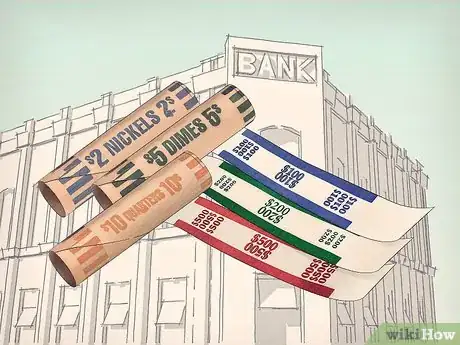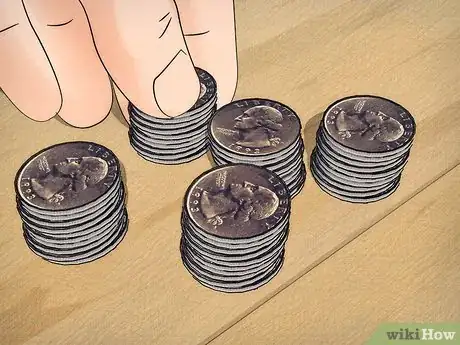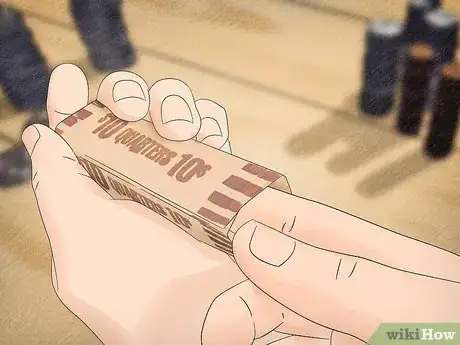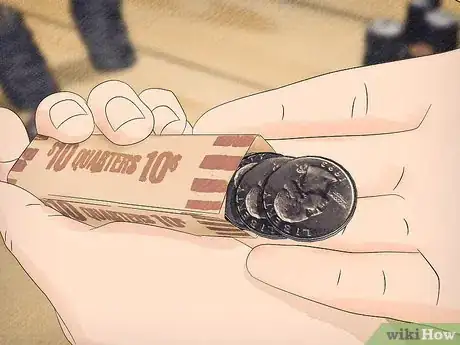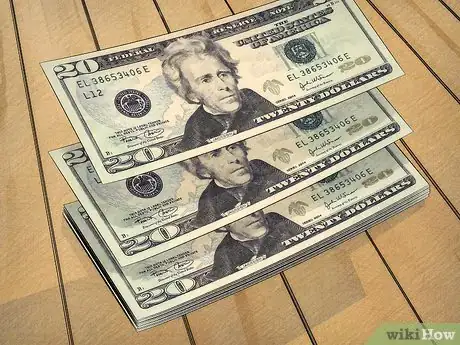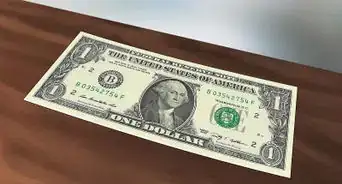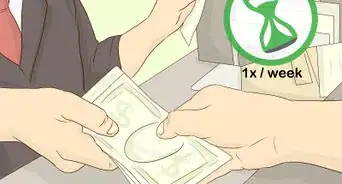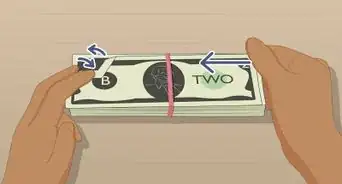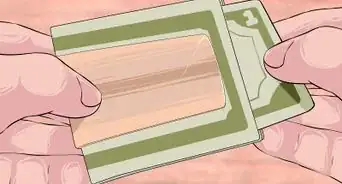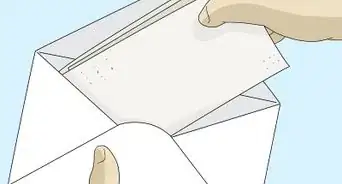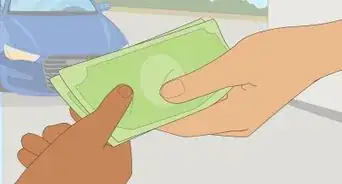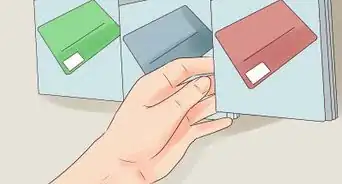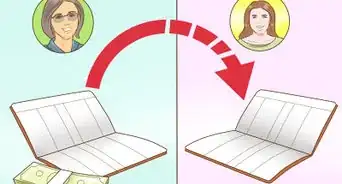This article was co-authored by wikiHow Staff. Our trained team of editors and researchers validate articles for accuracy and comprehensiveness. wikiHow's Content Management Team carefully monitors the work from our editorial staff to ensure that each article is backed by trusted research and meets our high quality standards.
This article has been viewed 161,964 times.
Learn more...
If you save money in a jar or you take in a lot at a sale or other event, you may need to bundle it to take it to a bank. You may have a big jar full of coins and bills all mixed together, so sort those out first. Then sort all the money into piles of like denomination, such as ten-dollar bills, one-dollar bills, quarters, and dimes. When you get the money all sorted, you’ll put the coins into rolls and wrap the bills with currency bands.
Steps
Sorting the Money
-
1Get coin sleeves and currency bands from your bank or an office store. Ask the teller at your bank if they give out free sleeves and bands. Most banks do. Make sure you get sleeves and bands for each money denomination. If you don’t know how many you need, ask for five of each to start with.[1]
- If your bank does not give out money bundling supplies, most office stores and big-box stores carry them. Look for the individual denominations that you want, or buy a large pack of them all.
-
2Separate the bills from the coins. If your money is mixed together in a box or jar, dump it all out onto a table to sort it. Pick out the bills and make a stack. As you do this, let the coins sift into a pile of their own. Push the coins to one side of you and the bills to the other side.
- If you have only coins or bills, it is still easiest to sort the money if it is laid out on a table.
Advertisement -
3Sort the money into piles by denomination. Make a separate pile for each coin and bill. Sort one pile each of pennies, nickels, dimes, and quarters. If you have a few other coins, like half dollars, separate those. You may have up to six piles of bills, which includes ones through hundreds.[2]
- Make sure your piles are far enough apart so they don’t get mixed up together.
- The two main sorting styles are either pulling out a single denomination at a time and piling it up or sorting all of the piles at once as you grab random pieces of money.
Rolling Coins
-
1Make piles of ten coins. Begin to count each value of coin into stacks of ten. This gives you an idea of how much you have total. It also helps you fill the coin sleeves later because the coins are all counted. Be careful not to knock them over or you’ll make more work for yourself.[3]
- For example, you might end up with four stacks of ten pennies, one stack of ten nickels, six stacks of ten dimes, and three stacks of ten quarters.
- Your coins probably won’t come out into exact stacks of ten, so pile the extras in a separate stack. Write down how many extras you have so you don’t have to count them again later.
-
2Open flat coin sleeves so they form a tube. Squeeze the edges of the coin sleeve and insert your thumb in one end of the sleeve. Press the edges until they touch each other and the sleeve forms into a square tube. Make a few more creases to round it out.[4]
-
3Block one end of the sleeve with your thumb. The easiest way to insert coins into the sleeve is to insert your thumb to block one end of the tube. When you do this, it forms a stopping point for the coins when you drop them in the tube. If your thumb is too thick, use a different finger.[5]
- Since each coin is a different size, the tubes they go in are different sizes, as well. Use whichever finger fits best into the tube.
-
4Slide the stacked coins into the tube. If you picked up a penny sleeve, grab a stack of pennies and slowly slide them into the tube. Make sure they stack on top of each other properly. Count the designated amount into the tube.
- Each coin roll is meant to hold a specific amount of a certain coin. Make sure you check the sleeves and count carefully as you go so you insert the right number of coins.
- Roll 50 pennies for a value of 50 cents. Rolls 40 nickels for a value of two dollars. Roll 50 dimes for a value of five dollars. Roll 40 quarters for a value of $10.
Using Currency Bands
-
1Divide the bills into counted stacks. Check the currency bands that you have to find out how much money they each hold. Then pick up each denomination of bill one at a time and count the bills into stacks that match the currency bands you’re using.[6]
- For example, common one-dollar bands hold $25, so you’d count the ones into piles of 25. Twenty-dollar bills are bundled as $500, so you’d make piles of 25 bills.
- Count each stack twice to make sure every stack has the right amount.
-
2Put extra bills to the side in a stack separate from the rest. Your money probably won't count out into even piles. Save the extra bills for the next time you bundle up your money. Make sure they don’t get mixed in with your counted stacks and mess them up.
-
3Turn the bills in each pile to face the same direction. If you’ll be turning the money in at a bank, it’s important that the bills are facing the same direction. Sort through the stacks and turn all of the bills so they face the same way.[7]
- When banks count the money, it makes a teller’s job easier if all of the bills are facing the same direction. Save yourself time at the bank by taking care of this before you get there.
-
4Count each stack again before you band it. With the stacks counted and facing the same way, count all of them again to check the number of bills. Sort out any pile that wasn’t counted right the first time. It’s easy to miscount, and it causes problems later if you don’t check.
- If you didn’t check the currency bands when you sorted and counted earlier, check them now. Make sure all of the stacks have the right amount of money for the bands you’re using.
-
5Wrap the currency bands around the stacks of money. Start with the lowest denomination bill you have, and band each stack with the appropriate band. If the bands are adjustable to different sized bundles of money, make sure you tighten them around the stack of money.
- Currency bands may have self-sticking glue, or they may require you to peel a piece of plastic off of the sticky part. Others may form a single loop so they fit an exact amount of money.
Community Q&A
-
QuestionWhat is a bundle of money?
 DonaganTop AnswererIt is a collection of coins or bills of a single denomination, such as a roll of quarters or a banded stack of one-dollar bills.
DonaganTop AnswererIt is a collection of coins or bills of a single denomination, such as a roll of quarters or a banded stack of one-dollar bills. -
QuestionWhat amount do I brick in $100.00 bills to sell it to the government?
 Community AnswerOne hundred 100 dollar units or $10,000 to be more precise. They also traditionally have a mustard colored band.
Community AnswerOne hundred 100 dollar units or $10,000 to be more precise. They also traditionally have a mustard colored band. -
QuestionWhen bundles of two dollar bills come in from the bank, how much will each cash bundle have?
 Community AnswerA bundle typically consists of 10 straps, or 1,000 units. Each strap of $2 bills is worth $200, so a bundle of $2 bills carries a value of $2,000.
Community AnswerA bundle typically consists of 10 straps, or 1,000 units. Each strap of $2 bills is worth $200, so a bundle of $2 bills carries a value of $2,000.
References
- ↑ https://www.mybanktracker.com/news/coin-counting-machines-banks-where-find-them
- ↑ http://www.ebay.com/gds/Your-Guide-to-Properly-Filling-and-Closing-Coin-Rolls-/10000000178589961/g.html
- ↑ http://www.ebay.com/gds/Your-Guide-to-Properly-Filling-and-Closing-Coin-Rolls-/10000000178589961/g.html
- ↑ https://www.youtube.com/watch?v=OcjHjrvktEo&feature=youtu.be&t=1m39s
- ↑ https://www.youtube.com/watch?v=OcjHjrvktEo&feature=youtu.be&t=1m52s
- ↑ https://otm.finance.harvard.edu/how-to/bundle-cash-and-coin
- ↑ https://otm.finance.harvard.edu/how-to/bundle-cash-and-coin
About This Article
Bundling your money is an easy way to sort it and keep track of how much you have. You’ll need coin sleeves and currency bands, which you can get from most banks and office stores. Start by separating your money by coin and bill denominations in stacks of 10. Count your bills into stacks that correspond with the currency on your band. For instance, count 25 dollar bills and wrap them with a 25-dollar band. Make sure all the bills are facing the same way to make it easier to count. To bundle coins, stop the end of a coin sleeve and insert a stack of the same denomination to help you count your coins. For example, 40 nickels equal 2 dollars and 50 dimes equal 5 dollars. Count any loose coins and bills at the end. For more tips, including how to count stacks of dimes and pennies, read on!
